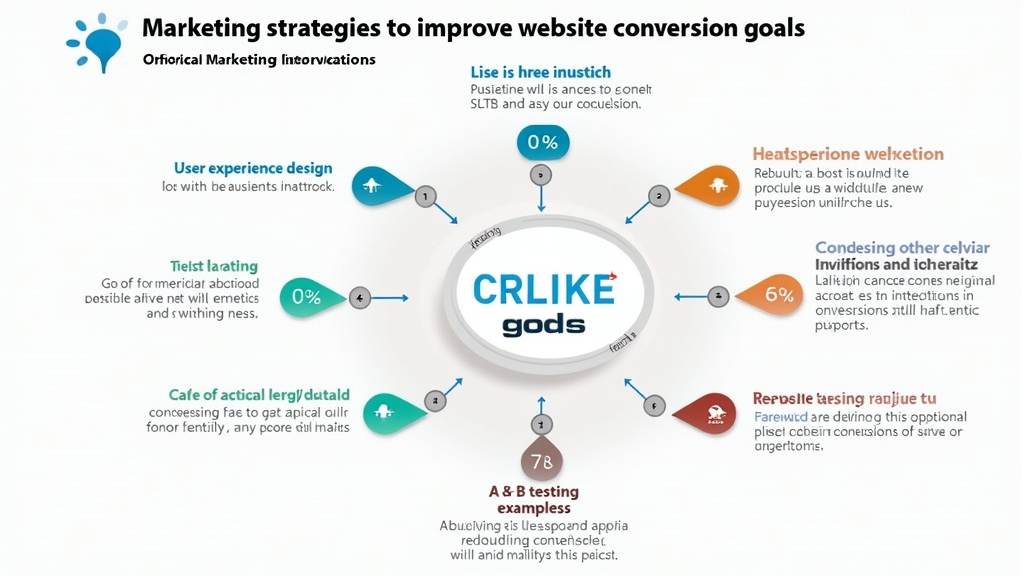Marketing Strategies to Achieve Website Conversion Goals
Introduction
In the world of online marketing, achieving website conversion goals is crucial for your success. These goals help you understand what actions you want visitors to take on your site, whether it’s signing up for a newsletter or making a purchase. Setting clear conversion goals not only guides your marketing efforts but also helps measure their effectiveness. By focusing on these objectives, you can enhance user experience and drive more meaningful interactions with your audience.
Understanding Website Conversion Goals
Definition of Conversion Goals
Conversion goals are specific actions that you want users to complete on your website. These actions can vary based on your business objectives and target audience. Essentially, they represent the desired outcomes from visitors engaging with your content.
Types of Conversion Goals
There are several types of conversion goals that businesses often focus on:
- Lead Generation: This goal involves collecting contact information from potential customers, such as email addresses or phone numbers. It’s essential for building a customer database.
- Sales Conversion: This is perhaps the most straightforward goal—encouraging visitors to make purchases directly through your website.
- Engagement Metrics: These include actions like downloading resources, sharing content on social media, or spending time reading articles. They indicate how well users interact with your site.
Understanding these different types will help you tailor strategies that align with each specific goal.
The Role of Marketing in Driving Conversions
Integrating Marketing Efforts with Conversion Goals
Marketing plays a vital role in driving conversions by aligning all efforts toward achieving defined goals. This means creating targeted campaigns that resonate with potential customers and guide them through the buying process effectively.
Importance of Target Audience Identification
Identifying your target audience is critical for successful marketing strategies. Knowing who they are allows you to craft messages and offers that appeal directly to their needs and interests. When marketing aligns closely with audience expectations, conversions naturally increase.
Effective Strategies to Improve Website Conversions
Optimizing User Experience (UX)
User experience (UX) refers to how easy and enjoyable it is for visitors to navigate your website. A well-designed UX can significantly boost conversions by ensuring users find what they need quickly and effortlessly. Key elements include fast loading times, mobile responsiveness, intuitive navigation, and clear information architecture.
Utilizing A/B Testing for Better Outcomes
A/B testing involves comparing two versions of a webpage to see which performs better in terms of conversions. By testing different headlines, images, or layouts, you can gather data about what resonates most with users. This method allows continuous improvement based on real user behavior rather than assumptions.
Implementing Call-to-Actions (CTAs)
Best Practices for Creating Effective CTAs
Call-to-actions (CTAs) are prompts that encourage users to take specific actions—like “Sign Up Now” or “Buy Today.” To create effective CTAs:
- Use action-oriented language.
- Make them visually distinct using contrasting colors.
- Keep them concise yet compelling.
These practices ensure that CTAs stand out and motivate users to engage further.
Placement and Design Considerations
The placement of CTAs is just as important as their design. Position them where users naturally look during their journey—such as at the top of pages or after informative content sections—to maximize visibility and clicks.
Analyzing and Measuring Success
Key Performance Indicators (KPIs) for Website Conversions
To evaluate success in achieving conversion goals, track key performance indicators (KPIs). Common KPIs include conversion rate percentage, average order value, bounce rate, and customer acquisition cost. Monitoring these metrics provides insights into how well you’re meeting objectives.
Tools and Techniques for Tracking Conversions
Utilize tools like Google Analytics or specialized software like HubSpot to track conversions effectively. These platforms offer detailed reports about user behavior on your site so you can identify trends over time and adjust strategies accordingly.
Common Challenges in Achieving Conversion Goals
Identifying Bottlenecks in the Conversion Funnel
Sometimes visitors drop off before completing desired actions due to bottlenecks within the conversion funnel—areas where user flow slows down or stops entirely. Identifying these points requires analyzing user pathways through analytics tools so you can address issues proactively.
How to Overcome Resistance from Potential Customers
Resistance may arise when potential customers hesitate due to concerns about price or trustworthiness. To overcome this challenge:
- Provide testimonials from satisfied customers.
- Offer guarantees or free trials.
- Clearly communicate value propositions that highlight benefits over costs.
By addressing these concerns head-on, you’ll build confidence among potential buyers leading them closer toward conversion decisions.
Conclusion
Achieving website conversion goals requires strategic planning combined with ongoing analysis of results achieved through various methods discussed here—from optimizing UX design down through effective CTA implementation techniques! Remember always refine approaches based upon data-driven insights gained along this journey towards greater online success!
📢 Explore More: Continue Your Journey!
If this article helped you understand how marketing strategies impact website conversions effectively check out How User Experience Influences Online Sales! It covers essential tips helping improve customer satisfaction while boosting sales performance even further!














![NEEWER 55W 18"/45cm Ring Light Kit [New Version], 5600K Dimmable ...](https://m.media-amazon.com/images/I/414QLqvZWLL._AC_.jpg)








